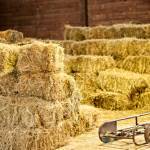Storing Hay for Horses

Follow these tips to keep stored hay dry and clean.
- Be sure hay is dry before stacking it in a barn or shed. Damp hay that begins to decompose can generate enough heat to burn down your barn. If the hay is newly baled, check for a musty or moldy smell, and break open a couple of bales to check for heat and mold. Any bales that seem a lot heavier than the others are likely to contain a level of moisture that may be unsafe.
- Store hay in a dry place. Before placing hay in a barn or shed, check the roof for leaks. Don’t stack hay directly on the ground. If hay must be stored outside, prepare a pad of gravel several inches thick and raised slightly above ground level. Cover the bales loosely, but allow for some air circulation.
- Stacking the bottom layer of bales, and then every second layer, with the cut ends up and the twine or wire on the sides will encourage drying.
- Allow air circulation under and around the bales. Barn lofts are often constructed with some space between the boards for this purpose. Stacking bales in several smaller piles rather than making one enormous pile allows for better airflow.
- Placing a lightweight tarp over the bales will protect them from sunlight, dust, and some animal droppings and urine. Don’t cover the pile tightly as this may trap moisture and lead to mold formation.
- If there is evidence of mice, rats, opossums, or raccoons in your hay storage area, use traps or contact a wildlife relocator to minimize the population. You probably can’t guarantee a creature-free barn, but fewer visitors means less chance of spreading some equine diseases that are carried in the urine and feces of wild animals.
- Feed the last of an old delivery of hay first, mixing in some new hay as you get to the last bales in the stack.








